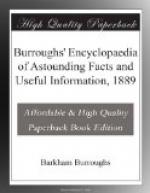SIGNS OF STORMS APPROACHING.—A ring around the sun or moon stands for an approaching storm, its near or distant approach being indicated by its larger or smaller circumference. When the sun rises brightly and immediately afterward becomes veiled with clouds, the farmer distrusts the day. Rains which begin early in the morning often stop by nine in place of “eleven,” the hour specified in the old saw, “If it rains before seven.”
On a still, quiet day, with scarcely the least wind afloat, the ranchman or farmer can tell the direction of impending storm by cattle sniffing the air in the direction whence it is coming. Lack of dew in summer is a rain sign. Sharp white frosts in autumn and winter precede damp weather, and we will stake our reputation as a prophet that three successive white frosts are an infallible sign of rain. Spiders do not spin their webs out of doors before rain. Previous to rain flies sting sharper, bees remain in their hives or fly but short distances, and almost all animals appear uneasy.
HOW TO DISTINGUISH GOOD MEAT FROM BAD MEAT.
1st. It is neither of a pale pink color nor of a deep purple tint, for the former is a sign of disease, and the latter indicates that the animal has not been slaughtered, but has died with the blood in it, or has suffered from acute fever.
2d. It has a marked appearance from the ramifications of little veins of fat among the muscles.
3d. It should be firm and elastic to the touch and should scarcely moisten the fingers—bad meat being wet and sodden and flabby with the fat looking like jelly or wet parchment.
4th. It should have little or no odor, and the odor should not be disagreeable, for diseased meat has a sickly cadaverous smell, and sometimes a smell of physic. This is very discoverable when the meat is chopped up and drenched with warm water.
5th. It should not shrink or waste much in cooking.
6th. It should not run to water or become very wet on standing for a day or two, but should, on the contrary, dry upon the surface.




